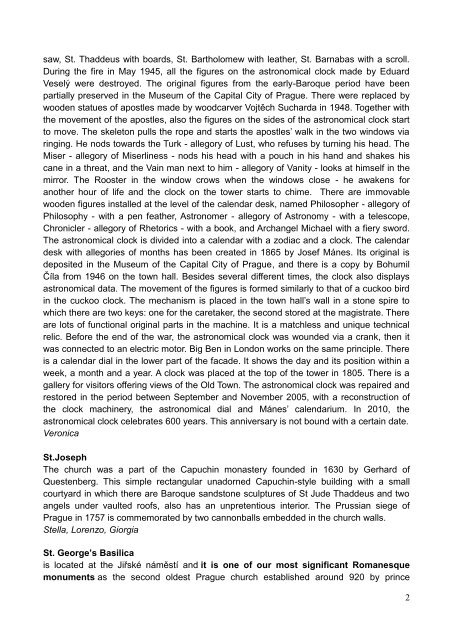PRAGUE presentation 3f
Create successful ePaper yourself
Turn your PDF publications into a flip-book with our unique Google optimized e-Paper software.
saw, St. Thaddeus with boards, St. Bartholomew with leather, St. Barnabas with a scroll.<br />
During the fire in May 1945, all the figures on the astronomical clock made by Eduard<br />
Veselý were destroyed. The original figures from the early-Baroque period have been<br />
partially preserved in the Museum of the Capital City of Prague. There were replaced by<br />
wooden statues of apostles made by woodcarver Vojtěch Sucharda in 1948. Together with<br />
the movement of the apostles, also the figures on the sides of the astronomical clock start<br />
to move. The skeleton pulls the rope and starts the apostles’ walk in the two windows via<br />
ringing. He nods towards the Turk - allegory of Lust, who refuses by turning his head. The<br />
Miser - allegory of Miserliness - nods his head with a pouch in his hand and shakes his<br />
cane in a threat, and the Vain man next to him - allegory of Vanity - looks at himself in the<br />
mirror. The Rooster in the window crows when the windows close - he awakens for<br />
another hour of life and the clock on the tower starts to chime. There are immovable<br />
wooden figures installed at the level of the calendar desk, named Philosopher - allegory of<br />
Philosophy - with a pen feather, Astronomer - allegory of Astronomy - with a telescope,<br />
Chronicler - allegory of Rhetorics - with a book, and Archangel Michael with a fiery sword.<br />
The astronomical clock is divided into a calendar with a zodiac and a clock. The calendar<br />
desk with allegories of months has been created in 1865 by Josef Mánes. Its original is<br />
deposited in the Museum of the Capital City of Prague, and there is a copy by Bohumil<br />
Číla from 1946 on the town hall. Besides several different times, the clock also displays<br />
astronomical data. The movement of the figures is formed similarly to that of a cuckoo bird<br />
in the cuckoo clock. The mechanism is placed in the town hall’s wall in a stone spire to<br />
which there are two keys: one for the caretaker, the second stored at the magistrate. There<br />
are lots of functional original parts in the machine. It is a matchless and unique technical<br />
relic. Before the end of the war, the astronomical clock was wounded via a crank, then it<br />
was connected to an electric motor. Big Ben in London works on the same principle. There<br />
is a calendar dial in the lower part of the facade. It shows the day and its position within a<br />
week, a month and a year. A clock was placed at the top of the tower in 1805. There is a<br />
gallery for visitors offering views of the Old Town. The astronomical clock was repaired and<br />
restored in the period between September and November 2005, with a reconstruction of<br />
the clock machinery, the astronomical dial and Mánes’ calendarium. In 2010, the<br />
astronomical clock celebrates 600 years. This anniversary is not bound with a certain date.<br />
Veronica<br />
St.Joseph<br />
The church was a part of the Capuchin monastery founded in 1630 by Gerhard of<br />
Questenberg. This simple rectangular unadorned Capuchin-style building with a small<br />
courtyard in which there are Baroque sandstone sculptures of St Jude Thaddeus and two<br />
angels under vaulted roofs, also has an unpretentious interior. The Prussian siege of<br />
Prague in 1757 is commemorated by two cannonballs embedded in the church walls.<br />
Stella, Lorenzo, Giorgia<br />
St. George’s Basilica<br />
is located at the Jiřské náměstí and it is one of our most significant Romanesque<br />
monuments as the second oldest Prague church established around 920 by prince<br />
2



